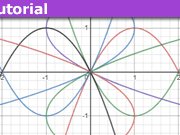A Continuous, Nowhere Differentiable Function: Part 1
When studying calculus, we learn that every differentiable function is continuous, but a continuous function need not be differentiable at every point. A standard example is ##f(x) = |x|##, which is continuous everywhere, and differentiable everywhere except at ##x=0##.
In this series of articles, we will construct a function that is continuous everywhere, but differentiable nowhere.
It is possible to construct such a function by summing a sequence of scaled and shifted copies of the absolute value function: ##g(x) = \sum_{n=0}^{\infty}a_n |x – b_n|##. By carefully choosing the sequences ##(a_n)## and ##(b_n)##, one can make ##g## continuous and nowhere differentiable.
We will use a different approach which will allow us to have some fun with Fourier series. Let us start by writing down two general expressions for the Fourier series of an even, ##2\pi##-periodic, real-valued function with zero mean:
$$h(x) = \sum_{n=1}^{\infty} a_n \cos(nx) = \text{Re}\left(\sum_{n=1}^{\infty} a_n e^{inx} \right)$$
where ##(a_n)## is a sequence of real numbers. The terms of this series are continuous and differentiable (infinitely many times) at every point, yet as we will see, it is still possible to choose ##(a_n)## such that ##h## is continuous but nowhere differentiable.
Let’s examine what properties we will require from ##(a_n)## in order to achieve this. First, a sufficient condition to ensure continuity of ##h## is to require ##\sum_{n = 1}^{\infty} |a_n| < \infty##. Indeed, if this condition holds, then the inequality ##|a_n \cos(nx)| \leq |a_n|## implies that the series ##\sum_{n=1}^{\infty} a_n \cos(nx)## is absolutely convergent at every point. Furthermore, by the Weierstrass M-test, the series is also uniformly convergent, so ##h## is continuous.
Now, what about nowhere differentiability? If we define the power series
$$p(z) = \sum_{n=1}^{\infty} a_n z^n$$
then ##h(x) = \text{Re}(p(e^{ix}))##. The radius of convergence of this power series is
$$R = \frac{1}{\limsup |a_n|^{1/n}}$$
If ##R < 1##, then the power series will diverge on the unit circle ##|z| = 1##, so the Fourier series ##h(x)## will also diverge at every point. If ##R > 1##, then the unit circle ##|z| = 1## is contained in the interior of the disk of convergence, so ##p## is analytic on the unit circle, and consequently, ##h## is not only continuous but differentiable infinitely many times at every point. In other words, if ##R > 1##, then ##h## will be a ##C^\infty## function, also known as a smooth function. So, if we want ##h## to be continuous but nowhere differentiable (or, more generally, to be anything but a smooth function), we need to choose ##(a_n)## such that ##R = 1##. This is a necessary, but not sufficient condition.
Summarizing, a sufficient condition for ##h## to be continuous is ##\sum_{n=1}^{\infty} |a_n| < \infty##, and a necessary condition for ##h## to be nowhere differentiable is ##\limsup |a_n|^{1/n} = 1##. We will restrict our attention to functions satisfying both of these criteria. One such function is the Weierstrass function (more precisely, family of functions):
$$w(x) = \sum_{k=0}^{\infty} \alpha^k \cos(\beta^k x)$$
where ##0 < \alpha < 1##, and ##\beta \geq 2## is an integer. Comparing this with the Fourier series expression
$$\sum_{n=1}^{\infty}a_n \cos(nx),$$
we see that the series defining ##w## is indeed a Fourier series, with the property that the only nonzero coefficients are the ones associated with the frequencies ##n=\beta, \beta^2, \beta^3, \ldots## Thus there are increasingly large gaps between nonzero coefficients as ##n## increases. Specifically,
$$a_n = \begin{cases}\alpha^k & \text{if }n = \beta^k \\ 0 & \text{otherwise}\end{cases}$$
Such a series is called a lacunary Fourier series. (“Lacuna” is simply a fancy word for “gap.”) Since
$$\sum_{n=1}^{\infty}|a_n| = \sum_{k=1}^{\infty}\alpha^k =\frac{\alpha}{1-\alpha} < \infty,$$
the convergence is uniform, so ##w## is continuous for any fixed ##\alpha \in (0,1)##. Also,
$$|a_n|^{1/n} = \begin{cases} |\alpha|^{k / \beta^k} & \text{if }n = \beta^k \\ 0 & \text{otherwise}\end{cases}$$
Since ##\alpha > 0## and ##k / \beta^k \to 0## as ##k \to \infty##, it follows that ##\limsup |a_n|^{1/n} = 1## and therefore the radius of convergence is ##R = 1##. This means that the necessary condition for ##w## to be nowhere differentiable is satisfied.
Can we find a sufficient condition for ##w## to be nowhere differentiable? A general principle with respect to the Fourier series is that smoother functions have coefficients that decay more rapidly as ##n \to \infty##. A nowhere differentiable function will be very un-smooth, so we want the Fourier coefficients ##a_n## to decay slowly (we want more contribution from the high-frequency components), while maintaining the constraint ##\sum_{k=1}^{\infty}|\alpha^k| < \infty## to preserve continuity.
The form of the function ##w(x) = \alpha^k \cos(\beta^k x)## gives us two knobs to play with: ##\alpha## and ##\beta##. As long as ##0<\alpha<1##, we maintain uniform convergence, hence continuity. For a given choice of ##\alpha##, we can slow down the decay by increasing ##\beta##. In 1872, Weierstrass proved that as long as ##\beta## is large enough to satisfy ##\alpha \beta > 1 + 3\pi/2##, then ##w## will be nowhere differentiable. This condition was later improved by Hardy to ##\alpha \beta \geq 1##.
You can see a plot of what this function looks like for a suitable choice of ##\alpha, \beta## at the Wikipedia page for Weierstrass function.
The remaining parts of this article will present a proof of Weierstrass’s result, with just enough background material to make it self-contained without having to read 100+ pages to get to the nice proof in Stein and Shakarchi’s Fourier Analysis, which we will follow in spirit.








Leave a Reply
Want to join the discussion?Feel free to contribute!